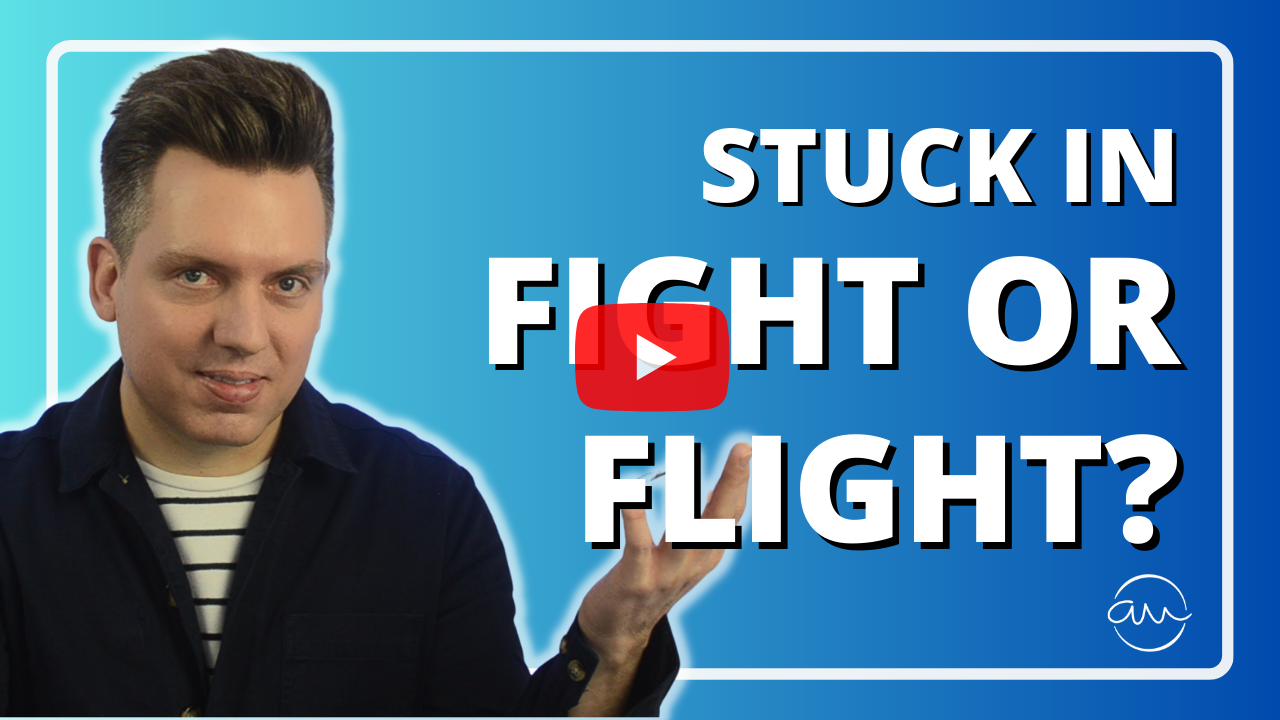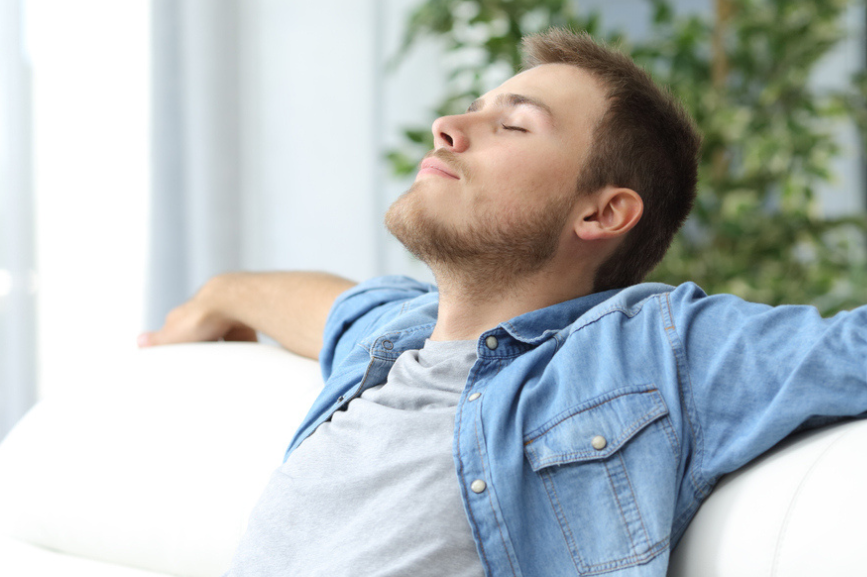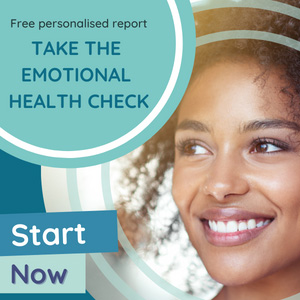If you're dealing with ongoing stress and pressure or anxiety, no doubt you've experienced the fight or flight response. It's how your body responds under stress to help you deal with the perceived threats caused by what's happening in our lives.
So in this article, we're going to explore 6 simple and highly effective habits that you can build into your daily life, that will help you deal with stress and anxiety more effectively whilst helping you lower your response to ongoing stress - engaging your parasympathetic nervous system so you can soothe and settle any negative feelings happening.
And, before we look at the 6 ways your can calm your fight, flight, freeze response, it's really helpful to understand a bit more about how it works and what's happening in the brain, because this knowledge can make a big difference in your ability to begin taking control of stress and anxiety.
What is the fight, flight, freeze response?
Your fight-flight-freeze response is your body's natural response to danger and threats. It's stress response that kicks in to keep you safe, think of it as a survival mechanism to perceived threats, which happens when we believe we're in danger, being threatened or even being asked to do more than we have the resources to cope with, it isn't a conscious decision, it's an automatic reaction.
Interestingly, it's not just triggered by real things and events happening to us, it's also tiggered by the way we think about situations and events in our lives. Our imagination is so powerful that negative thinking, worrying about a potential threat, or ruminating on things that went wrong in the past, or even the thought of standing up and giving a speech can tigger your stress response too.
When stress has been happening for a long time, it can have a negative impact and lead to a dysregulation of your nervous system which basically means, it can lead to a prolonged state of anxiety, worry, trouble sleeping and various other problematic internal responses, and long term it can impact your mental and physical health.
Watch this video on 6 Easy Habits To Turn Off The Fight, Flight Response (How To Engage Your Parasympathetic Response)
Learn about the six very simple yet important techniques that will help you deal with stress and anxiety more effectively as you soothe your nervous system.
What happens in the brain when your fight, flight, freeze response increases?
When you experience a fight, flight, or freeze response, your brain and body react to a perceived threat or danger. It's an automatic response that prepares you to take action. Let's explore what happens in your brain during this response and how it can affect your thinking and responses.
- Activation of the Amygdala:
- Release of Stress Hormones:
- Increased Heart Rate and Blood Pressure:
- Diversion of Blood Flow:
- Heightened Alertness:
- Impaired Thinking and Responses:
- Emotional Responses:
The amygdala, a part of your brain that deals with emotions, especially fear and anxiety, comes into play. When it senses danger, it quickly sends signals to kickstart the fight, flight, or freeze response.
Your amygdala communicates with the hypothalamus, which regulates your stress response. The hypothalamus activates the sympathetic nervous system, triggering the release of stress hormones like adrenaline and cortisol into your bloodstream.
Adrenaline causes your heart rate and blood pressure to rise, preparing your body for action. This ensures that your muscles receive enough oxygen and nutrients to help you respond quickly.
In a fight or flight situation, blood flow is redirected away from non-essential functions, such as digestion, and towards your major muscle groups. This redirection helps improve physical performance and reaction time.
The release of stress hormones and increased blood flow to your brain enhance your alertness and sensory perception. You become more tuned in to your surroundings, including potential threats.
While the fight or flight response is important for survival, it can impact certain cognitive functions. The increased levels of stress hormones, particularly cortisol, may affect your thinking and decision-making abilities. Cortisol can interfere with memory, attention, and concentration, causing you to focus more on the perceived threat.
The fight, flight, freeze response can also influence your emotions. Heightened fear and anxiety might make you more emotionally reactive, leading to defensive or aggressive behaviour.
Remember, the fight, flight, freeze response is a normal and adaptive reaction to threats. However, extended or excessive activation of this response can have negative effects on your physical and mental well-being. So, learning effective stress management techniques as those that follow can help you regulate your responses and reduce the impact of stress on your thinking and behaviour.
6 Simple Ways to Calm Anxiety Naturally
Here are six simple habits that you can build into your daily life, that will help you deal with stress and anxiety more effectively and over time as you practice these habits they will help you lower you response to ongoing stress and pressure, reducing anxiety whilst engaging your parasympathetic nervous system which counteracts the body's stress response, so you can soothe and settle any negative feelings happening.
1. Box Breathing
Deep breathing is the foundation skill for calming down your nervous system, because your breathing directly reflects the level of tension you carry in your body. Under tension your breathing usually becomes shallow and rapid and occurs high in the chest. When you are relaxed you breathe more fully more deeply and from your abdomen. So, when you practice breathing deeply you stimulate the parasympathetic nervous system and that's the branch of your autonomic nervous system that promotes that state of calmness and quietness. Creating greater feelings of connectedness between mind and body.
How to do box breathing: Start by exhaling completely, then inhale slowly to a count of four, hold your breath for four counts, exhale slowly for four counts, and finally, hold your breath for another four counts. Repeat this cycle for several minutes, focusing on maintaining a steady rhythm and visualization. This technique helps regulate your breath, promoting a sense of calm and balance in stressful situations. Adjust the timing to suit your comfort level.
2. When you feel triggered, practice the 90 second rule
The 90-second rule is a wonderful habit you can develop through practice, and it can truly help you regulate your responses to everyday situations. You have the power to choose how you want to be in the world, moment by moment. By taking control of your thoughts, you can have control over the way you respond.
So, the next time something happens and you feel triggered, pay attention to those thoughts and feelings. Take a deep breath and simply wait for 90 seconds. You can look at your watch or check the time on your phone, but the key is to pause and observe yourself having this physiological response without getting caught up in it. Trust me, it takes less than 90 seconds for you to start feeling better and for those feelings to not escalate.
From the moment you think the thought that triggers your response, it takes less than 90 seconds for the chemicals to flush out of your system. To make this even more effective, find some mental space by going into another room, and you can even combine this practice with box breathing for added relaxation and focus.
3. Seek out moments that make you smile and laugh!
Laughter is an incredible tool that can have a positive impact on our well-being. Not only does it give us a mini workout by engaging our lungs and boosting blood flow, but it also breaks through low moods and leaves us with that wonderful feel-good sensation. Even a simple smile can do wonders for our overall health! The muscle action required for a smile actually creates a calming effect on our nervous system, so even if it's forced, it can still have the same positive impact.
Here's a quick and enjoyable exercise you can do every day: challenge yourself to find something that makes you laugh or smile. Write it down as a reminder of those moments that brightened your day. By actively seeking out things that bring joy and laughter, you'll develop a habit of embracing positivity. Take a moment to review your list and savour those memories - it might even make you laugh all over again! It's no wonder that laughing feels so good. It helps to replace stress-inducing cortisol in our bloodstream with feel-good chemicals in the brain like dopamine, oxytocin, and endorphins. This not only releases tension but also reduces the overall stress response.
So go ahead, embrace laughter and smiles as powerful tools for your well-being. They have the incredible ability to uplift your mood and bring joy to your life.
4. Make relaxing music part of your daily routine
Music is a remarkable tool for reducing stress and promoting relaxation. When we listen to calming melodies, it has the power to transport us to a different world, offering a temporary escape from our worries. Not only does music activate our body's natural relaxation response, but it also stimulates pleasure and emotion centres in the brain, creating a sense of tranquillity and even euphoria.
By incorporating relaxing and uplifting music into our daily routines, we can enhance our well-being, lower stress levels, and experience moments of joy. So, take a few moments each day to tune in, unwind, and let music be your friendly companion on the journey to relaxation and self-care.
5. Exercise (or physical activity)!
Being active is not only beneficial for your physical health but also has a remarkable impact on your mental well-being. When you engage in physical activity, it triggers the release of chemicals in your brain that make you feel good, boosting your self-esteem, enhancing concentration, improving sleep, and overall making you feel better. And the best part? Many of us can do it for free!
Exercise has a profound effect on lifting your mood, and there are fascinating psychological reasons behind this. As you exercise, it increases blood flow to your brain, elevating the levels of brain chemicals such as serotonin and dopamine. These chemicals play a crucial role in promoting happiness and reducing the fight-or-flight response, ultimately helping you feel less stressed. And if you choose to exercise outdoors, you gain an additional benefit - the natural light stimulates serotonin production, further enhancing your well-being. It's amazing how higher serotonin levels can make us feel good, while dopamine creates a sense of motivation and adds to that feel-good factor.
Now, you might wonder, how active do you really need to be? The key is simply to get moving. Take a walk, for example. Find an activity that you truly enjoy and make it a part of your routine. If possible, involve a friend or combine it with another enjoyable activity, like finishing your walk or run with a relaxing tea or coffee in a cosy cafe. Not only will this make your exercise more enjoyable, but it also provides an opportunity to shift your attention away from yourself and any problems you may be facing, allowing you to spend quality time with others. This social connection further enhances the positive impact on your well-being.
So, let's get active in a way that brings you joy and fits into your lifestyle. Whether it's going for a stroll, dancing to your favourite tunes, or playing a sport, make it a delightful and fulfilling experience. Remember, being active is not only good for your body but also a fantastic way to boost your mood, reduce stress, and create more meaningful connections with others.
6. Use the power of positive visualization (Mental Rehearsal)
Let me explain a helpful technique used in therapy called visualization. It may sound simple, but it can be incredibly powerful in accessing your inner resources while deeply relaxed. Visualizing is a method we use to break unhelpful thought patterns and replace them with better ones. Think of it as a mental rehearsal for your brain, setting the expectation for yourself that things will go well and that you will succeed.
How to do visualization: Start by taking some time to relax. Find a quiet and comfortable space where you can unwind. Once you're relaxed, begin to visualize a specific successful outcome of a situation or event that you will soon face. Let's say you usually feel anxious about giving a presentation at work. Imagine yourself confidently starting to speak, feeling calm, at ease, and breathing effortlessly. Visualize yourself in control, expressing your thoughts with clarity and confidence.
Try playing out the scenarios in your mind, focusing on the messages or points you want to convey. Pay attention to the gestures you might use, the eye contact you'll make, and even imagine the questions you might receive. Encourage yourself by repeating positive affirmations like, "I can do this, I've got this." Notice how you stand confidently, using body language that shows you are knowledgeable and capable.
This technique empowers you, shifting your focus from worrying about a negative outcome to embracing a positive and successful experience. Consistently practicing visualization creates healthier patterns for your brain to match, replacing old negative ones when you encounter similar situations in real life.
Remember, visualization is a powerful tool that can enhance your confidence and mental preparation. By regularly engaging in this practice, you can create a positive mindset and increase your chances of success in various aspects of your life.
Finally, if you've been dealing with ongoing stress and anxiety for a while, these habits are a really good foundation that will help you when you need to calm down, relax and long term help you cope so much better. But you may also want to consider seeking out professional support from a therapist and talking therapies like cognitive behavioural therapy or hypnotherapy can really help you resolve the thoughts and reactions that creates anxiety, whilst helping relax your mind and body, breaking the often-debilitating cycle of anxiety and dread naturally.
How does hypnotherapy help reduce the fight or flight response?
Hypnotherapy is an incredibly helpful and supportive approach to reducing the fight or flight response in a gentle and calming manner. Through hypnosis, the mind and body are brought into a state of relaxation, allowing for a sense of calmness to prevail, allowing you to switch off your stress response and relax.
One of the key benefits of hypnotherapy is that it includes a period of positive talking therapy before we do the hypnosis. This gives you the ability to identify and address the underlying causes of your fight or flight response, including stress, anxiety, and trauma. By exploring these root causes, you gain valuable insights and can then make positive changes that enable you to better control your reactions in the future. This, in turn, helps to diminish the negative effects associated with the fight or flight response, as anxiety and stress is reduced too.
The other benefit of course is that hypnotherapy offers the opportunity to cultivate positive coping skills. Relaxation techniques and positive self-talk are integrated into the sessions, empowering you to effectively manage and reduce the intensity of your responses to situations. By practicing these techniques regularly, you'll develop a greater sense of resilience and calmness in the face of challenging situations.
How does Solution Focused Hypnotherapy Work?
In my clinical practice online, my approach is solution focused which means sessions are designed to help you tap into your inner resources and develop practical solutions to challenges. It encourages a positive mindset, self-belief, and a proactive approach to achieving your positive changes and desired outcomes. I understand that your journey towards change is unique to you, so I'm there to support you every step of the way.
Does solution focused hypnotherapy calm anxiety?
Yes, solution focused hypnotherapy can help calm anxiety. By combining elements of hypnosis and solution-focused talking therapy, this approach can be effective in reducing anxiety symptoms and promoting a sense of calm and well-being. It combines relaxation techniques, positive suggestions, visualization exercises, and goal oriented talk therapy to help alleviate anxiety symptoms and promote a sense of calm.
During solution focused hypnotherapy sessions, you'll experience deep relaxation and stress reduction, which alone can have a soothing effect on anxiety. During hypnosis you'll be provided with positive suggestions tailored to ease anxious thoughts and reframe negative thinking patterns, encouraging a more positive and relaxed mindset.
Visualization exercises are used to imagine yourself in calm and anxiety-free situations. This mental rehearsal helps create a sense of control and peace, positively influencing your experience in real-life anxiety-provoking situations.
One of the strengths of solution focused hypnotherapy is its focus on building coping strategies and resilience. The therapy empowers you to recognize your strengths and develop effective ways to manage anxiety, boosting your confidence in overcoming anxiety inducing challenges.
A goal oriented approach forms part of the solution focused talking therapy, which helps you shift your focus from anxiety symptoms to your desired outcomes. By envisioning a positive future and identifying small steps towards your goals, anxiety can be reframed as a hurdle that can be overcome which leads you onto greater and greater confidence, success and control over your life.
How do I start online hypnotherapy?
If you'd like to explore how hypnotherapy could help you, please get in touch for a free initial chat to explore your situation and discover what your personalised plan might look like.








